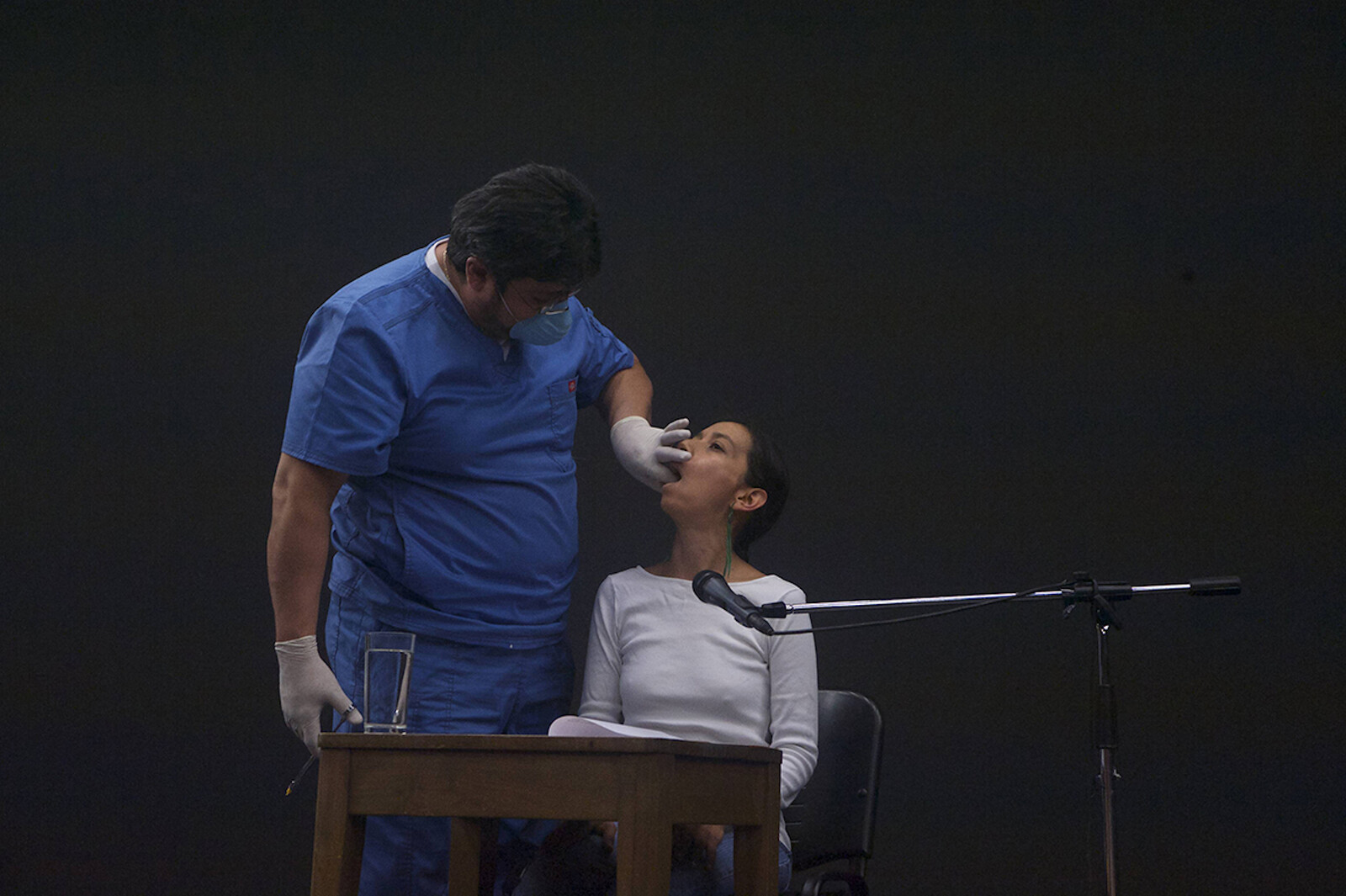In 1960, angered by the deeply skewed land deals between the right-wing dictatorship and US companies such as United Fruit, a group of left-wing army officers tried to wrest control of Guatemala. They failed and over the ensuing 36 years, tacitly aided by Washington, the government coordinated the murder and disappearance of an estimated 200,000 people, most of them indigenous Maya civilians.1 In her video La Verdad (2013), for more than an hour, the Guatemalan performance artist Regina José Galindo reads out traumatic testimonies from the victims of these events.
Shot from a single static camera, it is the first of three documentary works in this small show, each of which is given its own room. Galindo wears a white top against a black background, reading in monotonous Spanish from a stapled block of paper: “they took out the baby and tied it up and there were some who got together to make a fire.” It continues in this gruesome and unsettling vein until, around five minutes in, a man enters the frame. Galindo stops reading and puts her head back. The man injects a dental anesthetic into her gums. As the drugs begin to work, the artist continues, her mumbled words only semi-coherent—a manifestation of the memories she speaks: “they covered my mouth so I couldn’t scream.” The anesthetist reappears regularly throughout the reading.
The show’s title points to the etymological connection between “anesthetic,” “amnesty,” “amnesia,” and “aesthetics,” joining absence to sensing and perception. As Galindo reads out the crimes of the past, I think of a recent interview I conducted myself, as a journalist, in which a woman revived her own childhood trauma. Was that for my benefit, or hers? Is the act of remembering itself a good enough justification for the pain it can cause or is it better to become numb to this stuff? If so, how? Guatemala went through a truth and reconciliation process, but Efraín Ríos Montt, the military dictator responsible for approximately 10,000 of those extrajudicial killings, died peacefully at home aged 91 in 2018. Six years prior, a Guatemalan court had convicted him of genocide, but the country’s constitutional court overturned the decision on appeal a mere ten days later.
The question of whether art is the appropriate forum to address such fraught memory—at a time when trauma is increasingly used as curatorial currency—is interrogated in El Objetivo. In this performance, which Galindo made for Documenta 14, in 2017, visitors were invited to point an assault rifle (manufactured by German firearms company Heckler & Koch) at the artist. In the video documentation presented here, projected on the wall of the smallest of coleção moraes-barbosa’s three rooms, the camera is positioned so we don’t see Galindo, just gallery goers holding and looking at the gun, perusing it like any other art object. With this self-deprecating angle, the artist astutely questions her own intentions and ethical imperative.
It also puts the onus on us, the viewer. Art becomes a sight hole through which we engage victims of history, with all the power imbalance that implies. In judging Documenta’s visitors for inspecting the gun as calmly as they appeared to be doing, I suddenly felt myself in the frame, too, for having sat through the luridly explicit violence described in the previous work and seemingly numbed to the horrors Galindo described. This potential voyeurism is replicated in America’s Family Prison (2008) the final work to be encountered in the show. A small monitor on the floor of the gallery’s third room shows CCTV footage, capturing highlights of the 24 hours Galindo spent with her young family in a prefabricated modular prison cell bought from a company that normally supplies the US prison system.
One might question what purpose this aesthetic recreation of America’s penal system serves, given that Galindos’s “release” is assured after a single day. Such questions, however, are central to her interrogative and self-reflexive approach, allowing her to comment on the ethics of politically-minded art practices in a nuanced, open-ended way. That this exhibition is both outward facing, a straight narration of history, and astute to the sensitivities involved in that process demonstrates a maxim: how we tell stories is as important as the story itself.
See the US Institute of Peace 1997 Truth Commission on Guatemala: https://www.usip.org/publications/1997/02/truth-commission-guatemala.






